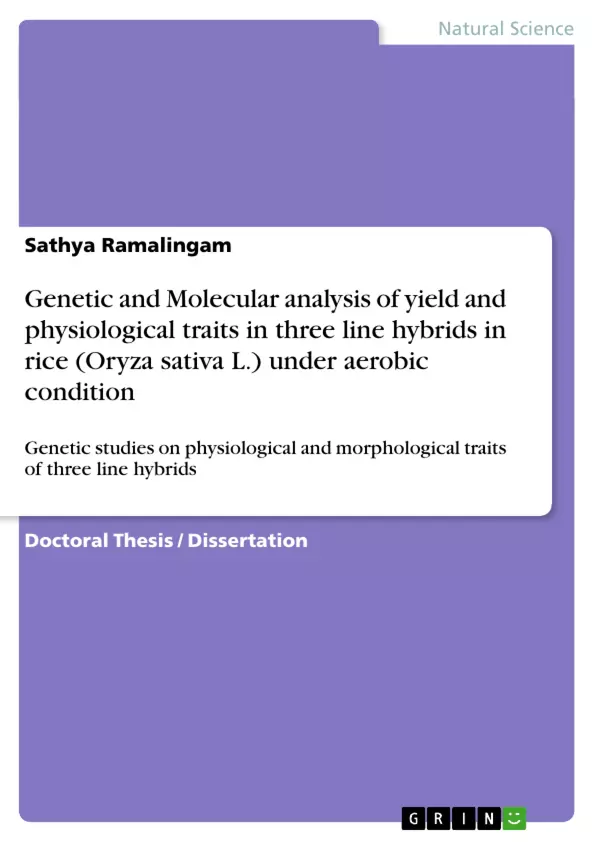An investigation in rice (Oryza sativa L.) was carried out subjecting six ‘lines’ and 15 ‘testers’ crossed in a Line x Tester mating design to estimate gene action, combining ability and heterosis for yield and drought tolerant traits under aerobic condition. The 21 parents were also surveyed using SSR markers.
From the Line x Tester analysis, the hybrids exhibited significant variation among themselves for all the characters studied under aerobic condition. The study of gene action for drought tolerance and yield component traits revealed that all the traits exhibited dominant gene action which was predominant. Therefore, to harness the dominant gene effects, either heterosis breeding or selection at later generations would be an appropriate breeding methodology.
Based on the per se performance of lines and testers, the following parents i.e., IR79128A (L1), IR79156A (L2), COMS14A (L5), COMS24A (L6), IR 80286-22-3-6-1R (T3) and IR7925A-428-2-1-1R (T4) were adjudged as the best parents and crosses involving them would be expected to throw desirable segregants for both yield and drought tolerant traits under aerobic condition.
Based on the gca effects, the parents IR79128A (L1), IR70369A (L4), IR79156A (L2), BI-33 (T15), IR79582-21-2-2-1R (T5), KMP-105 (T11), T1 (IR 69726-29-1-2-2R) and MAS - 946-1 (T9) were the best general combiners and the crosses involving them would result in the identification of superior segregants with favourable genes for both drought and yield.
Out of 21 parents evaluated based on per se and gca effects, three
‘lines’ viz., IR79128A (L1), IR79156A (L2) and IR70369A (L4) and three ‘testers’ viz., IR7925A-428-2-1-1R (T11), KMP -148 (T12) and BI-33 (T15) were identified as the best genotypes which will be utilized in further breeding programmes as parents for improvement of yield and drought tolerance under aerobic conditions.
The cross combination IR70369A / MAS -26 (L4 x T10) was identified as the best for recombination breeding to get desirable segregants for yield and drought tolerant traits under aerobic conditions. The cross combinations viz., IR70369A / IR 7925A-428-2-1-1R (L4 x T4) and IR70369A / KMP-105 (L4 x T11) had high per se, sca effects and standard heterosis for drought tolerant and yield traits under aerobic conditions.
Inhaltsverzeichnis (Table of Contents)
- Introduction
- Review of Literature
- Objectives
- Materials and Methods
- Experimental Results
- Analysis of yield and yield contributing traits
- Yield and yield components
- Harvest index
- Biological yield
- Genetic parameters and correlation studies
- Analysis of physiological traits
- Leaf chlorophyll content
- Leaf area index
- Net photosynthesis
- Transpiration rate
- Water use efficiency
- Genetic parameters and correlation studies
- Genetic diversity analysis using molecular markers
- DNA isolation
- SSR analysis
- Data analysis
- Association mapping of yield and physiological traits
- Discussion
Zielsetzung und Themenschwerpunkte (Objectives and Key Themes)
This thesis aimed to investigate the genetic and molecular basis of yield and physiological traits in rice under aerobic conditions. The study focused on three-line hybrids, a promising approach for enhancing rice production in water-limited environments.- Genetic variation and heritability of yield and physiological traits in rice under aerobic conditions
- Correlation and path analysis of yield and yield contributing traits, and their association with physiological parameters
- Identification of molecular markers associated with yield and physiological traits using association mapping techniques
- Evaluation of the potential of three-line hybrids for improving rice production under aerobic conditions
- Insights into the molecular mechanisms underlying adaptation to aerobic conditions in rice
Zusammenfassung der Kapitel (Chapter Summaries)
- Introduction: This chapter provides an overview of rice production and the challenges posed by water scarcity. It discusses the importance of aerobic rice cultivation and the potential of three-line hybrids for enhancing yield and stress tolerance. This chapter also includes a comprehensive review of the literature on the genetic and molecular basis of yield and physiological traits in rice.
- Experimental Results: Analysis of yield and yield contributing traits: This chapter presents the results of field experiments conducted to evaluate yield and yield components, harvest index, and biological yield in three-line hybrids. The study investigates the genetic variation and heritability of these traits and explores their correlations and path coefficients.
- Experimental Results: Analysis of physiological traits: This chapter delves into the physiological responses of three-line hybrids to aerobic conditions. It examines leaf chlorophyll content, leaf area index, net photosynthesis, transpiration rate, and water use efficiency. Genetic parameters and correlations between these traits are analyzed to understand their role in yield performance.
- Experimental Results: Genetic diversity analysis using molecular markers: This chapter focuses on the genetic diversity among rice genotypes using molecular markers. It describes the DNA isolation and SSR analysis procedures and presents the genetic diversity estimates and population structure analysis.
- Experimental Results: Association mapping of yield and physiological traits: This chapter explores the association between molecular markers and yield and physiological traits. It identifies markers linked to traits of interest, providing insights into the genetic basis of adaptation to aerobic conditions.
- Discussion: This chapter summarizes the key findings of the study, discusses their implications for rice breeding, and highlights the potential of three-line hybrids for improving rice production under aerobic conditions.
Schlüsselwörter (Keywords)
Rice, three-line hybrids, aerobic conditions, yield, physiological traits, genetic variation, heritability, correlation, path analysis, molecular markers, SSR, association mapping, water use efficiency, adaptation, breeding.- Citation du texte
- Sathya Ramalingam (Auteur), 2012, Genetic and Molecular analysis of yield and physiological traits in three line hybrids in rice (Oryza sativa L.) under aerobic condition, Munich, GRIN Verlag, https://www.grin.com/document/201760



